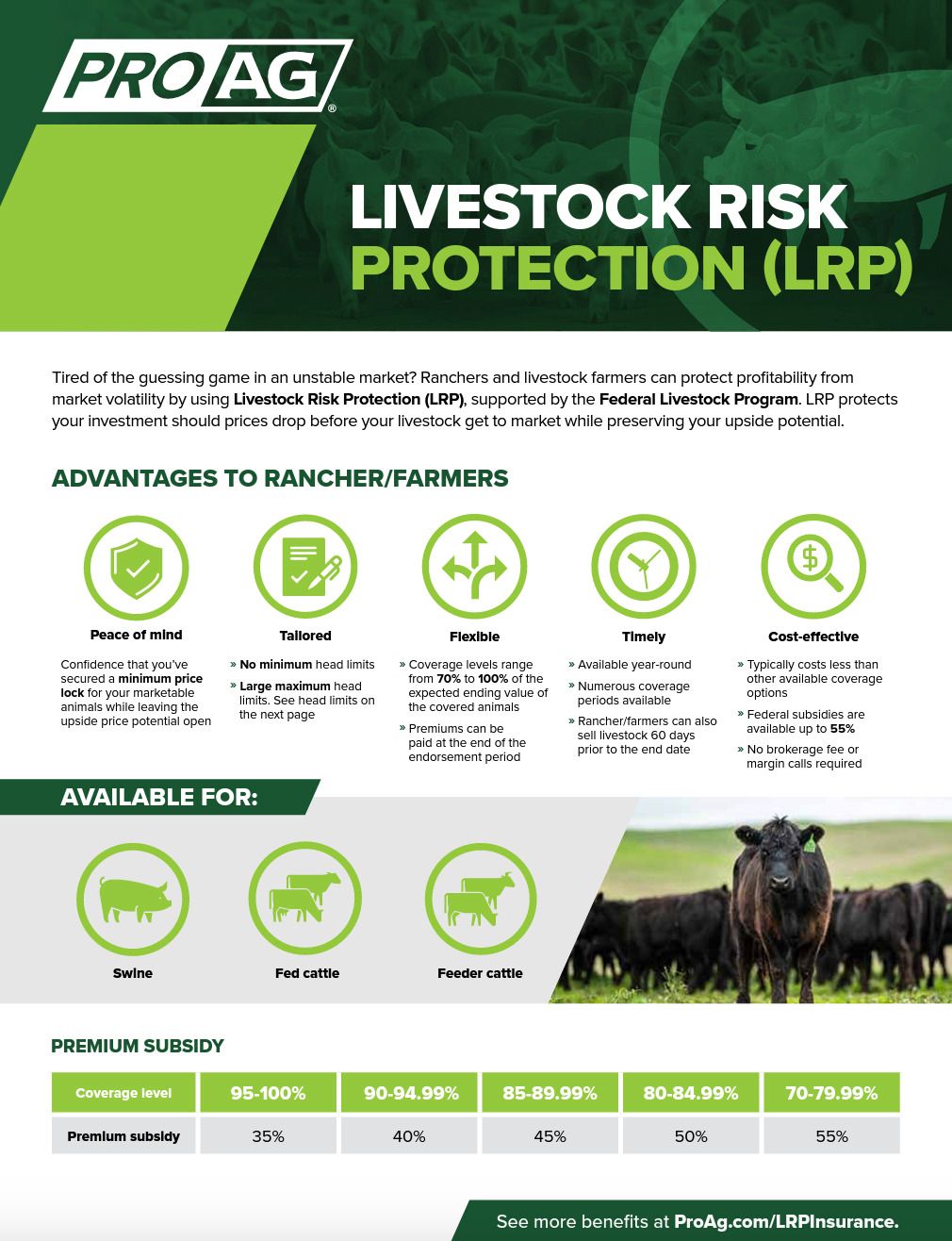Bagley Risk Management : Protecting Your Company Future
Bagley Risk Management : Protecting Your Company Future
Blog Article
Secret Variables to Take Into Consideration When Deciding On Animals Danger Protection (LRP) Insurance Policy
When evaluating choices for Animals Risk Defense (LRP) insurance coverage, numerous essential variables require mindful consideration to make sure efficient threat management in the farming industry. Selecting the right protection alternatives tailored to your details livestock procedure is paramount, as is comprehending just how premium costs associate with the degree of defense provided.
Protection Options
When considering Animals Threat Defense (LRP) insurance policy, it is essential to understand the numerous protection alternatives readily available to minimize dangers in the farming industry. Livestock Threat Security (LRP) insurance coverage uses different coverage alternatives customized to meet the diverse needs of animals manufacturers.
Another vital insurance coverage choice is the endorsement duration, which establishes the size of time the protection is in effect. Manufacturers can choose the endorsement duration that finest suits their production cycle and market conditions. Additionally, insurance coverage levels and rates differ based on the kind of livestock being guaranteed, offering manufacturers the flexibility to tailor their insurance coverage plans according to their certain demands.
Recognizing the different coverage alternatives offered under Animals Danger Defense (LRP) insurance coverage is essential for manufacturers to make informed choices that efficiently shield their livestock procedures from market uncertainties.
Costs Costs

Animals Danger Security (LRP) insurance coverage offers important coverage options tailored to mitigate dangers in the farming industry, with a significant aspect to take into consideration being the estimation and structure of premium prices. These include the kind and number of animals being insured, the coverage level picked, the current market rates, historic price information, and the size of the protection duration.
Premium expenses for LRP insurance policy are commonly computed based on actuarial information and run the risk of assessment versions. Insurance companies evaluate historic information on livestock costs and production prices to identify an appropriate costs that reflects the level of risk entailed. It is vital for animals producers to carefully review premium costs and insurance coverage options to guarantee they are effectively protected versus possible monetary losses as a result of unfavorable market problems or unforeseen events. By understanding exactly how exceptional costs are determined and structured, manufacturers can make informed choices when picking the best LRP insurance coverage for their operation.
Qualified Livestock
The resolution of qualified livestock for Livestock Threat Security (LRP) insurance coverage involves careful consideration of details requirements and qualities. Livestock kinds that are commonly qualified for LRP insurance consist of feeder cattle, fed lambs, swine, and livestock.
Feeder cattle, for instance, are typically eligible for LRP insurance coverage if they fall within defined weight varieties. Fed cattle might likewise be qualified, however they should fulfill specific weight and quality grade needs. Swine eligible for protection usually consist of market weight animals meant for slaughter. Lambs are an additional category of animals that can be thought about for LRP insurance, with variables such as weight and age playing a vital role in establishing their eligibility.
Before picking LRP insurance for livestock, producers need to thoroughly examine the qualification criteria described by the insurance policy provider to ensure their pets fulfill the necessary demands for protection.
Plan Adaptability
Policy flexibility in Animals Danger Defense (LRP) insurance policy enables manufacturers to tailor coverage to fit their specific demands and run the risk of monitoring techniques. This adaptability encourages livestock manufacturers to personalize their insurance policies based on variables such as the type of livestock they own, market problems, and specific danger resistance levels. By using customizable choices, LRP insurance policy allows manufacturers to effectively handle their risk exposure while guarding their livestock operations versus unforeseen market volatility.
Insurance Claims Refine
Upon experiencing a loss or damage, producers can start the cases process for their Livestock Danger Defense (LRP) insurance by quickly calling their insurance policy supplier. It is crucial see this for producers to report the loss immediately to quicken the claims process. When connecting to the insurance coverage provider, producers will need to supply thorough details concerning the incident, including the date, nature of the loss, and any type of appropriate paperwork such as vet documents or market value.

After the assessment is full, the insurance copyright will decide concerning the case and communicate the result to the manufacturer. The producer will get settlement according to the terms of their Livestock Risk Security (LRP) insurance coverage plan if the claim is authorized. It is crucial for producers to be familiar with the insurance claims procedure to ensure a smooth experience in case of a loss

Verdict
To conclude, when choosing Livestock Risk Protection (LRP) insurance, it is vital to think about coverage options, premium costs, qualified animals, plan adaptability, and the insurance claims process. These essential factors will certainly aid make sure that farmers and breeders are sufficiently safeguarded against possible risks and losses connected with their animals procedures. Making an educated choice based on these factors to consider can inevitably cause better financial protection and comfort for animals producers.
Animals Danger Protection (LRP) insurance policy uses different insurance coverage choices tailored to fulfill the diverse demands of livestock producers.The resolution of eligible animals for Livestock Risk Security (LRP) insurance protection involves cautious factor to consider of certain criteria and attributes.Policy adaptability in Livestock Danger Protection (LRP) insurance coverage allows manufacturers to customize protection to match their particular demands and risk monitoring strategies.Upon experiencing a loss or damages, manufacturers can start the cases process for their Livestock my review here Threat Protection (LRP) insurance coverage by without delay contacting their insurance coverage service provider.In final thought, when picking Livestock Threat Protection (LRP) insurance coverage, it is essential to consider coverage choices, premium prices, eligible animals, policy adaptability, and the cases process.
Report this page